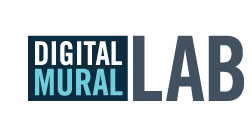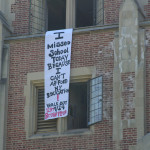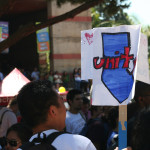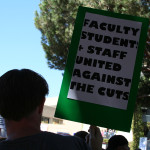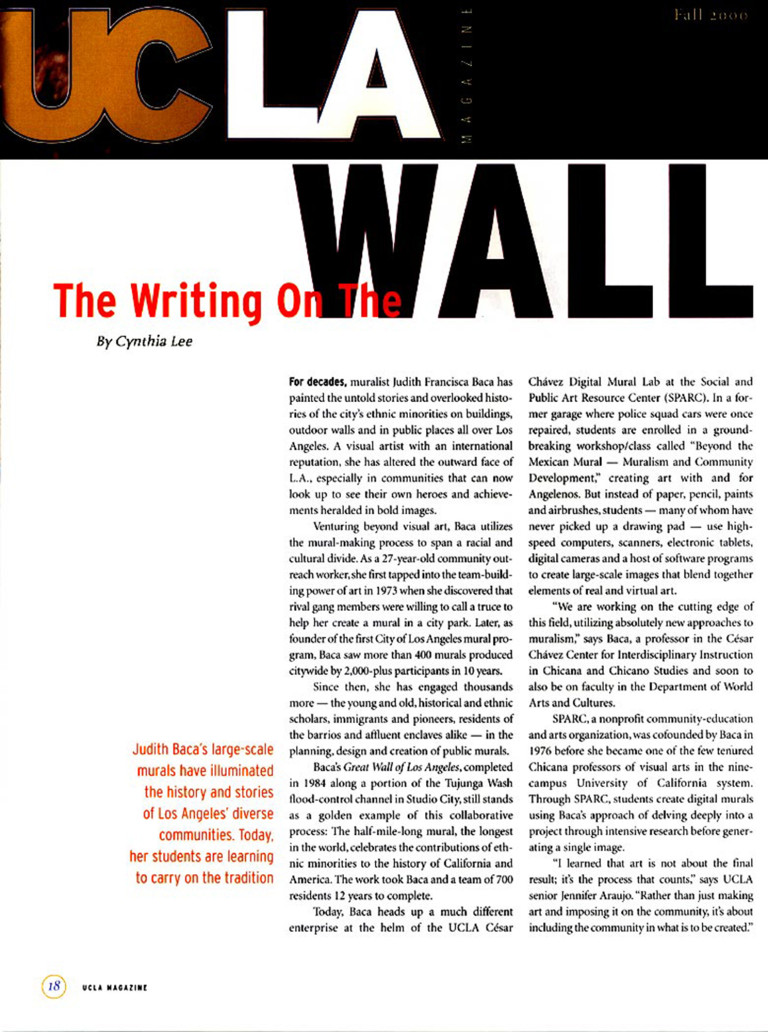The main demands of the UC strike are the following:
1. We demand that the Regents vote no on the proposed fee increases.
2. We demand that the UC stop cuts and layoffs, and end its aggressive union-busting tactics.
3. We demand transparency of the UC budget, including complete figures on how much of the additional revenue from fees will be diverted for construction and used as bond collateral.
4. We demand that the Regents expand enrollment of underrepresented groups and ensure equal access to education for all by maintaining all educational institutions as sanctuary spaces for undocumented students and workers and by providing adequate financial aid for undocumented and underrepresented students.
5. We demand an explanation for the failure of the UC leadership to make an effective case for public higher education. As both students and taxpayers, we demand leaders who can make that case, and an administration whose transparency can once again inspire the confidence of the state and its citizens.
Press conference today at the Great Wall of Los Angeles:
The Longest Mural in the World
The Great Wall of Los Angeles is getting a face-lift.
After many years, the mural has suffered extensive damage due to sun exposure and lack of restoration funds. Repair and repainting of the largest monument to interracial harmony in America continued this month and will startup again in the summer of 2010. SPARC has recruited a team made up of muralists, UCLA students and community youth, some include Great Wall alumni from the original 400 youth workers of thirty years ago.
“As SPARC’s first public art project and signature piece, I am proud to announce that the Great Wall has been declared a site of public memory worth preservation by California’s Cultural and Historic Endowment,” stated Judy Baca, Founder and Artistic Director of SPARC. The mural chronicles the contributions made by ethnic and diverse people to the history of America, in particular California; it goes from pre-historic time to the 1950’s.
About SPARC:
Creating Sites of Public Memory Since 1976. SPARC is committed to socially responsible art and art makers; to helping individual communities find their voice, giving it public expression, and having others hear it; breaking down barriers, real and perceived, between communities. What SPARC does is as much about public good as it is about public art.
See Great Wall Restoration in Faces
First 1000 feet restored.

Green Bridge
In addition to the mural’s face-lift, SPARC has partnered with the well-respected architecture firm, wHY Architects, to build an interpretive green bridge, a new component to the project. This newly designed replacement bridge will become a central public entrance and viewing platform for the mural and river. The defining metaphor of the Great Wall is: “a tattoo on the scar where the river once ran.” Therefore the “green bridge” will be built of recycled debris of the Los Angeles River.

Watch the first day of mural clean up.
Student Testimony
The Save LA Murals Presentation
An Audio Slideshow by Prof. Judith F. Baca – Presented to the City of Los Angeles Arts Commission on April 2nd 2009
BY GARY WALKER

The mural community received what many feel was a bittersweet victory on
February 19th, when the Los Angeles Planning Commission voted to view
murals and signs as separate objects, a position that artists have been
arguing for nearly a decade.
But their hopes that these artistic expressions would be incorporated into a new sign ordinance were
deflated when the commission voted to include murals in the new law
only after a number of other concerns about the proposed ordinance were
addressed.
“The distinction between murals and signs is simple;
it’s the intent,” said Judith Baca of the Social Art and Public
Resource Center (SPARC), a Venice-based nonprofit arts center that
produces and preserves public art. “If it’s about beauty or social
interaction, it’s a mural. If it’s designed to sell a product, then
it’s advertising, pure and simple.”
The proliferation of super graphics and outdoor advertisements have far
outpaced murals over the last ten years, a fact that causes artists like Baca great distress.
“Large parts of our city’s legacy are being forgotten or damaged by graffiti,
and as we lose these murals, we lose a part of ourselves,” said Baca,
SPARC’s founder.
The arts center has launched an initiative called the Mural Rescue
Program that began in February to drawattention to how murals have
become an afterthought to city officials and to resurrect the public’s
interest in the importance of these social art pieces.
According to Baca, each year, several murals
are painted over by city agencies or defaced by graffiti artists.
Contractors hired by the city government to remove “tagging” from city
property often damage murals, due to the chemicals that are used, and
the protective coating on murals is often damaged. In other cases,
SPARC representatives say that many murals are being painted over to
make room for super graphics and commercial art, which generates large
sums of revenue for municipal coffers.
“We are witnessing a massive corporatization of the public space,” said Baca.
Ava Porter, a photographer at SPARC, has a large role in the arts center’s
quest to preserve the remaining murals throughout the city, including
those in Venice, long considered a haven for artistic expression.
“The county and the city spend almost $70 million a year on graffiti
abatement and almost nothing on arts education,” Porter, a former
student of Baca’s at UCLA, pointed out. “The two things are not
mutually exclusive, and what we want to do is create a program to save
our remaining murals.”
The campaign’s Web site, SaveLAMurals.org/, gives an overview of its
plan to save the 105 murals that have been painted in Los Angeles over
the last three decades, many of them by disciples of Baca.
“Now is the time to turn hope into action by encouraging city officials
to reallocate a percentage of graffiti abatement monies to a Mural Rescue
Program and to save Los Angeles’ legacy of public murals,” the Web site states.
Porter says that this initiative can bring an added bonus.
“This is another way to employ youth as well and to educate them about the
importance of murals, and redirect youth that might be tagging,” she
said.
The Web site has had nearly 1,000 hits thus far, say SPARC
officials, and Baca says that the campaign has progressed better than
she had hoped.
“I think that it has been incredibly successful,
given the comments that we’ve received,” she said. “It really speaks to
the relationship between murals and the city.”
The plan to rescue artwork with social, historical and political content is being
conducted against the backdrop of another campaign being waged by
artists at City Hall.
Following a unanimous vote in December by the Los Angeles City Council
to place a three-month ban on commercial billboards and graphics,
the Planning Commission was instructed to review the city policy that
not only has disallowed murals nearly a decade, but views the distinct
art form the same as commercial signage.
“At the moment, there is no process for the permitting of murals,” Pat
Gomez, murals manager of the Department of Cultural Affairs, confirmed.
Muralists who feel that their unique artistic expressions have long been
suppressed in favor of commercial advertising are planning a full-court
press to influence the commissioners following the council’s moratorium
on billboards, and many see the consideration of a new sign ordinance
as an opportunity to resuscitate an artform that they feel has been
muted by city officials for far too long.
Supporters of public art came away pleased that the commission agreed
to acknowledge the distinction between murals and signs, but lamented
the decision to delay action on incorporating this provision into a
new ordinance until other matters are fully discussed.
“This means that we will have to wait that much longer to get an
ordinance that will allow for any form of a legal mural,” said Stash Maleski,
the director for In Creative Unity Art, a Venice-based art production
company specializing in murals.
Maleski was heartened by the commission’s decision to
work with the Cultural Affairs Commission and the Department of
Cultural Affairs to craft a future plan for murals.
“These are the appropriate city agencies to deal with issues of art and culture,” Maleski said.
William Caperton y Montoya, the director of marketing and development for the
Department of Cultural Affairs, indicated in a previous interview that
his agency has artists’ best interests in mind and looks forward to
working on the mural plan.
“We view murals as an artistic asset and we consider Los Angeles
to be the mural capital of the world,” Caperton y Montoya said.
“The department has the interests of the artists first and foremost,
and we want to do all that we can to make sure that these fine arts
murals do not disappear.”
While she believes that drawing the important difference between
commercial signs and murals is critical, Baca feels that the debate
is largely a distraction from what is really more pressing, which is the
preservation of these visual social commentaries.
“I don’t want to be distracted from the important issue, which
is the restoration of public art,” said SPARC’s founder.
“Public art is disappearing at an alarming rate and a generation
of young people will soon have not had the opportunity to work
on or see these murals.”
The commission will revisit incorporating murals into the new sign ordinance over the next several weeks.
Gail Goldberg, the director of the Planning Department, did not return calls for comment at Argonaut press time.
The art department of GCSU invited Judy Baca to hold a day-long workshop for Advanced Painting Students on March 5, 2009 to learn the techniques, practice and theory that she has cultivated over her 30+ years as an artist and teaches her UCLA class, Beyond the Mexican Mural. Though it would be impossible for a one-day workshop to cover as much material as a full ten- to twenty-week course, Baca’s workshops are in depth and rigorous. In only 5 hours, she was able to turn twenty individual art students into one mural team moving from “Affinity Groups” to sketches to full composition and finally blue-line on the wall. Their professors will see them through paint application.


1. Judy Baca introduces herself and her mural process which follows the theory of Paolo Freire in which content is derived from the overlapping stories of participants.

2. Students are given ten index cards each. They are asked to write on each card a life-defining epiphany and what they learned from the experience, then place the cards on the wall.

3. Students organize cards based on subject matter and create categories (i.e. substance abuse, advice from elders, love, communication, creativity.)

4. Once all the cards are categorized, students are instructed to stand in front of the category with which they most identify, creating “Affinity Groups.”

5. Affinity Groups break off the conceptualize their subjects. Each group will have 2-4 students who will begin by discussing the topic. Often times, each member will produce their own individual sketch but each group will ultimately complete one collaborative drawing.

6. As groups complete their drawings, Judy begins to determine composition and assigns each group to a portion of the gridded wall.

7. Students transfer their drawings onto the wall with charcoal following both their grids and the musical ratio of space division that Judy determines using the Punto system of David A. Siqueiros

8. Once charcoal drawings are complete, outlines are painted on with diluted aquamarine paint.
To complete a mural from start to finish requires a minimum of a two- to three-day workshop. In only one 5-hour day, Judy was able to orchestrate the conceptualization and drawing of a mural that will be colorized by the painting students over the rest of their semester with instruction from Professor Valerie Aranda (far right).
Stay tuned for updates as the students finish their work in Georgia . . .

Students of the GCSU Mural Workshop (at the end of a very long and productive day with Judy Baca). March 5, 2009.
Progress is made: The students continue to lay in blue-line for outlines and underpainting (images sent in by GCSU professors).




Students paint over the blue-line with acrylic paint
Professor Judy Baca’s “Beyond the Mexican Mural” includes collaborative project with sixth grade class
By Samantha Schaefer
Wednesday, March 4, 2009
To Alba Chacon, murals are a way to send a unifying message to a
community in need, but as a public health student with no artistic
experience, she said she felt nervous about contributing to one.
However, Chacon, a UCLA student working on her master’s in public
health and Latin American studies, said the technology used to create
murals in the César Chávez Digital/Mural Lab, located in Venice, levels
the playing field between artists and those who simply have ideas and
imagination.
Chacon and five other students in Professor Judy Baca’s “Beyond the
Mexican Mural” course are currently working on a mural for University
Elementary School, located on campus. The sixth grade class requested
that Baca and her students collaborate with them to create a mural as
its graduation present to the school, Baca said.
Baca, a longtime artist and activist, said her class allows her to work with communities that can’t afford to commission her.
Much of Baca’s curriculum is focused on muralist theory derived from
David Siqueiros, Diego Rivera and José Orozco, said Ava Porter, the
Social and Public Art Resource Center communications representative and
photographer.
The UCLA alumna and former student of Baca said the three muralists
are widely known as “Los Tres Grandes,” the three great Mexican
muralists of the 20th century.
Baca said she studied in Mexico under Siqueiros prior to creating the mural programs in Los Angeles.
“It’s really exciting that our school is going to have a mural that
is part of this tradition of muralism that goes back to these three
great artists in Mexico,” said Scott Smith, a sixth-grade social
studies and visual arts teacher at the elementary school.
The theme of the mural, submitted by the sixth graders, is “We are
one, we are many.” The mural features a history of dance, from a
painted circle of indigenous dancers to an energetic James Brown.
Painted photos of the elementary school students from the hip-hop
class that inspired Baca’s students were also incorporated into the
mural.
The mural illustrates the UCLA students’ vision of how all humans
are interconnected, represented with ciphers, the Earth and Pangea, a
unified continent, as well as DNA emerging from a fire surrounded by
dancers.
“It’s set in space to give it a fantasy, whimsical thing and to
represent the macrocosm and how we all come together in the large
scale,” said Bree Hemingway, a fourth-year history student.
“The smoke coming out of the fire is actually DNA, which shows how
we come together on a smaller scale. We’re all from the same stuff.”
After Baca’s students visited the elementary school, they came up
with their own ideas for the piece and then decided which ideas they
liked best, she added.
“It’s a beautiful thing because it came from the children and came
from everyone’s interpretation of that one theme,” said Shonowa
Villalobos, fifth-year sociology student enrolled in the class.
The Digital/Mural Lab, created in 1996 and sponsored by SPARC,
contains computers on mobile drafting tables and large printers that
enable artists to print full-size murals.
“I haven’t taken a lot of art classes at UCLA, and so I felt like
this is a way I could get involved where I didn’t feel intimidated
because I hadn’t been doing art,” Hemingway said. “(The technology)
brought my strengths to the table and didn’t exclude me because I
didn’t have the artistic skills.”
Once drafted, the mural was printed to a half size for the UCLA
students to paint and then was scanned back into a computer and blown
up to full size for the sixth graders to finish painting.
The advantage to this technology, Baca said, is that murals can be
easily maintained, replaced and archived. She added that they are still
creating hand-crafted works in the lab by physically painting the
murals, which differentiates the works from billboards.
In addition to the mural, Baca’s students are creating a report on
the condition of all the murals throughout Los Angeles to submit to
legislators in hopes of receiving funding for the restoration and
preservation of those murals.
Baca said there has not been funding for mural programs for many
years, so the murals created by SPARC and other programs are not being
maintained.
SPARC focuses on at-risk community. Villalobos said she feels public
works are most important to at-risk communities, especially when there
is territorial violence.
“This is stuff that people kill over, for this little piece of land
that isn’t really theirs. So to have that sense of pride instilled in
this way, it does make a difference,” Villalobos said.
After working with Baca, Chacon said she hopes to use murals to get
messages about public health out to at-risk communities in a meaningful
and permanent way.
“The arts seems to be really unifying,” Chacon said. “It can
actually get a really controversial message across in a way that is so
participatory.”
